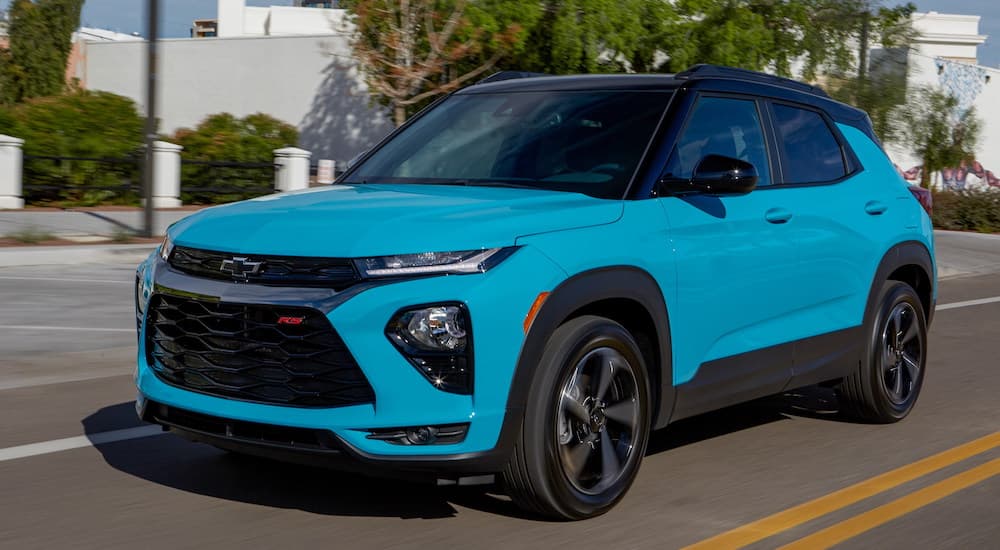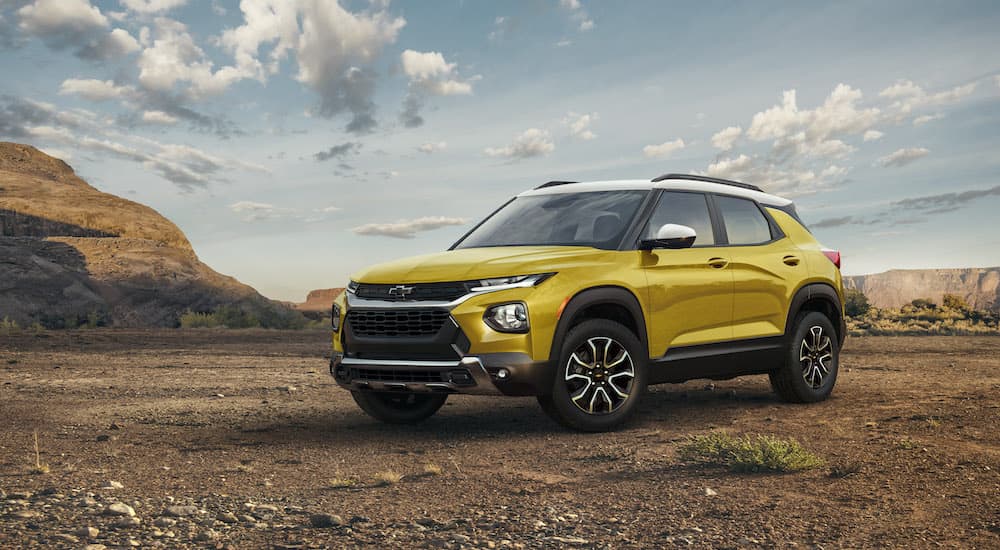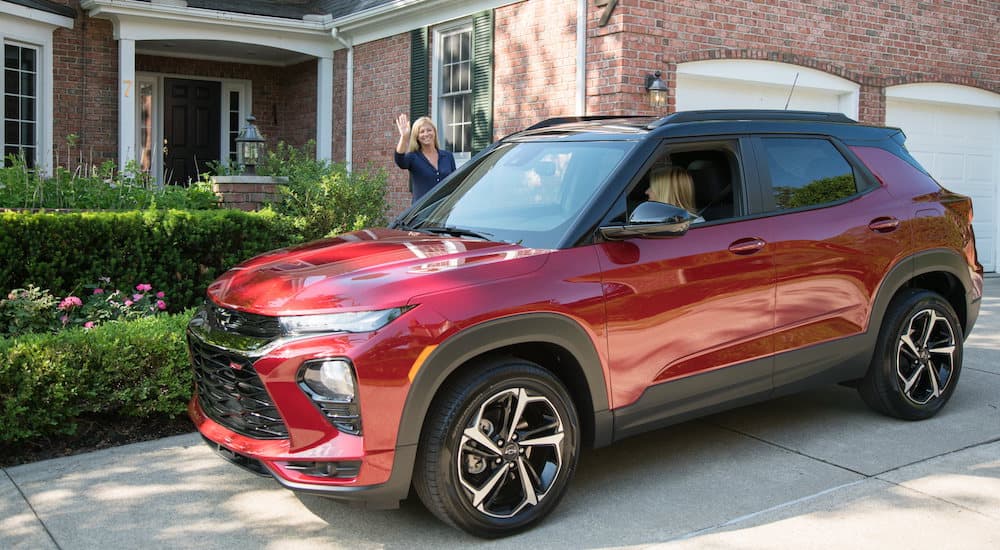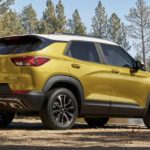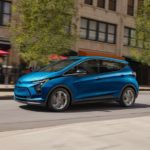Paint. We don’t often think about it as being a vital part of the vehicle until we go to buy and aren’t happy with the options available. When a company introduces a new model, it’s easy to just scroll by the color options and get to the specs. However, what do you focus on when the new model year has the same specs as the year previous because it is continuing the generation? Well, let’s look at the 2023 Chevy Trailblazer, for example.
New for the model year is a number of different paint options. It may not seem like much, but that was the focus for the new features being offered for the 2023 outing. The Trailblazer started its current generation back in 2021, so there isn’t much mechanically that needs to be upgraded for 2023. However, Chevy did add some fun colors. Now that might not seem all that exciting, but model color choices are important as they will directly affect the value of the model. How? Why? Well, let’s get into the nitty-gritty details to find out.
New Paints for 2023 and Why They Matter
The 2023 Chevy Trailblazer offers three brand-new exterior colors and one new roof color. The three body colors include Nitro Yellow Metallic, Fountain Blue, and Sterling Gray Metallic. The new roof color is Iridescent Pearl Tricoat, and it only comes with the Iridescent Pearl Tricoat body color. All of these new color schemes for the 2023 Trailblazer are premium colors that come at an extra cost, except for the Sterling Gray Metallic. They’re available as part of seven total exterior color options available for the Trailblazer, which also includes Summit White, Mosaic Black Metallic, and Vivid Orange Metallic.
The highlight here is that five of the seven color options are very obviously two-toned, giving the Trailblazer a very unique look, not unlike its larger sibling, the Blazer. However, the extra costs might not seem all that appealing to those looking for an affordable option. It’s important to remember that anything that isn’t gray, black, or white will cost more because it requires additional coats, layers of protection, additives, and other treatments to not only ensure the color comes out right but is also long-lasting, without fading, bleeding, or general decay. There’s a lot more to vehicle color than just pigment.
“But why should that matter to me?” you ask. A lot of people might be scratching their heads at the idea of premium paint colors, especially when 80% of the vehicles on the road are some shade of white, black, gray, or silver, according to a 2019 survey by Axalta. More specifically, these colors break down to 38% white, 19% black, and 13% gray. So what about all these other colors, and where do they rank on the list? Well, it varies per region and per demographic, as well as per vehicle.
Changes in Color Trends
A lot of the changes in what colors are popular on the road are based on what’s popular in modern culture. For instance, in the Axalta report, blue occupies the exterior paint scheme of 10% of vehicles across North America and Europe. Red also occupies about 9% of that market share of color schemes in America alone. Certain other colors are found to be more popular in specific regions of Asia, based on customary themes, cultural trends, and demographic shifts.
Various manufacturers have noted that consumer electronics, gadgets, and goods also influence color choices in vehicles. If you have a series of devices in a specific color scheme, some marketing and branding officers believe that these colors may be reflected in the choices consumers make when purchasing a vehicle, too.
Chris Kolter, a creative designer in the color and trim studio of GM’s North America Design at the time, told NBC News back in 2005….
“There’s also a lot going on with color right now. For a long time, we have had a silver and gray atmosphere, but now we are seeing the reintroduction of colors in fashion and other areas, and once we think consumers are comfortable with colors again, the next thing we’ll see is multiple combinations of colors working together as a package––two tone car colors, for example.”
That trend has continued to grow since then, which is evident with the color selections made available for the 2023 Chevy Trailblazer. It’s rather evident that certain market segments have bolder and more creative color schemes than others. This is actually done on purpose.
The Importance of Colors for Vehicles Like the 2023 Trailblazer
So why have we been stuck in the plain, boring, single-color body trend for such a long time? Why is that something we are still seeing even now? A lot of it boiled down to costs and longevity. However, with newer techniques in being able to explore more unique and original color schemes across a wider diversity of vehicle segments, we’re starting to see color come back in a big way.
One thing that is worth noting, though, is that many of these more boundary-pushing color schemes are being explored on vehicles that fit those exotic colors. Some people like their basic color schemes: nothing outside of gray, black, white, or silver. However, this is more demographic/segment oriented than just a general rule for the wide swathe of consumer drivers out there. As Barb Whalen, the designer manager for color and materials at Ford Motor Company explains, it’s not so much that people are averse to unique colors but mostly opposed to unique colors for certain vehicles.
For example, Whalen states, “Certain colors are appropriate for certain vehicles. For example, the Green Envy you would see on a Mustang, you would never put that on an F-150. It would just be kind of comical, I think. But a Mustang customer loves that bright green on that vehicle, and it’s appropriate, it’s inspired and it’s sporty, and there’s a customer out there that wants that attention, that wants to say, ‘Hey, look at me and look at my car.’”
Swap “F-150” with “Silverado” and “Mustang” with “Trailblazer,” and you can see that even across the competitive automotive landscape, that rule still applies. The Trailblazer is certainly a “look at me!” subcompact crossover. The futuristic design, sporty profile, and aggressive fascia already make it stand out. Giving it equally bold colors just makes sense, and this also plays a big part in how this vehicle may be adopted by consumers looking for something chic, compact, and cool. That’s not to mention how these colors will affect what the Trailblazer will be worth in the used markets.
2023 Trailblazer, Resale Values and Future Worth
It may not seem like it, but the Trailblazer is already blazing a trail for fetching a decent resale value based on its color scheme alone. Why? Well, so long as the paint scheme maintains its aesthetic integrity and the vehicle can still drive on the road, those unique color schemes Chevy has introduced for 2023 will give it way more resale value on the market down the road than if it were just a single-toned gray, silver, black, or white. Why? Exotic colors fetch more on the market.
As pointed out in a piece by the New York Times, even a 2017 Mazda Miata is worth $1,046 more if it has a unique paint job that isn’t gray, black, white, or silver––even if that more unique color is a basic red tone. Add in a two-tone flavor and exotic color options, and now you’re looking at a much higher resale value you can fetch for a vehicle like the 2023 Trailblazer. As noted in a report by Wards Auto, 88% of global car shoppers believe color is an extremely important factor when purchasing a vehicle, and it plays into the kind of vehicle they’re looking for, as well as what they believe it’ll be worth down the road.
It’s kind of looking beyond the present-day bubble when talking about future resale values, though. Realistically, we have no idea what the automotive market will look like in two years, five years, or a decade from now. However, one thing is absolutely clear: color is coming back. It’s worth more now than ever before, and it seems like automakers such as GM have realized this and are taking full advantage of it with unique new offerings like the ones in the 2023 Chevy Trailblazer.
